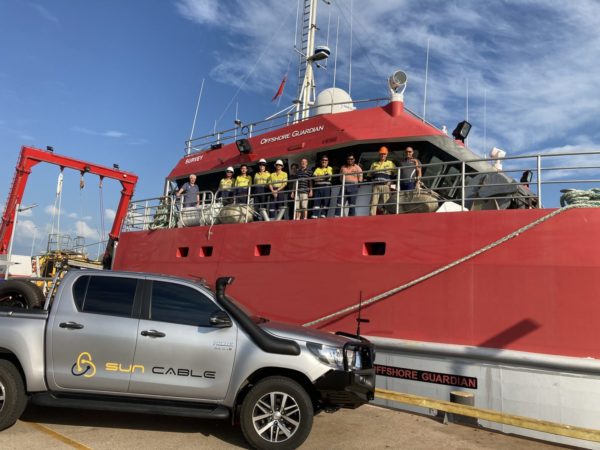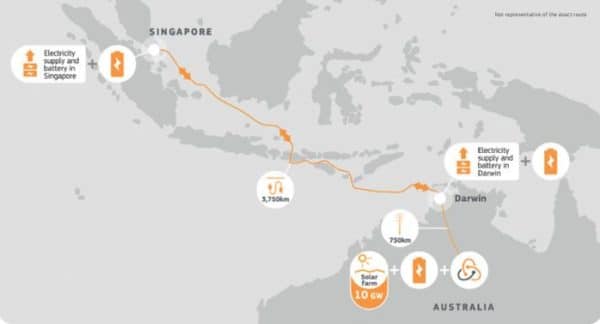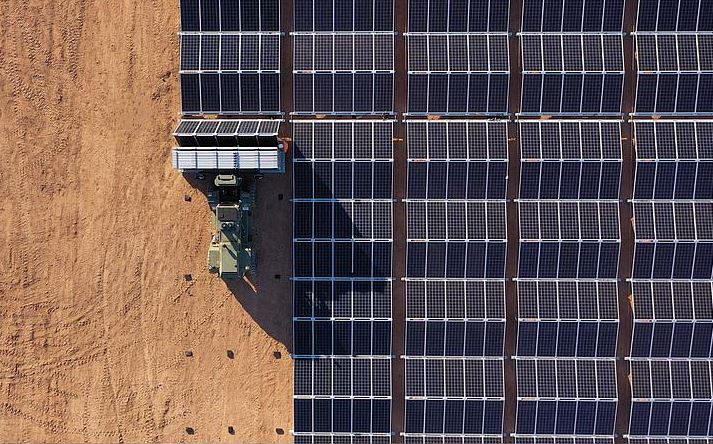Singapore-based Sun Cable has revealed the $30 billion Australia-Asia PowerLink (AAPL) project, which will supply electricity to Singapore from a massive solar PV farm and battery energy storage facility in Australia’s Northern Territory, is the “first of many” megaprojects it is looking to develop.
The revelation comes after Sun Cable this week announced the generation capacity of what is already shaping as the world’s largest solar PV and storage project would be ramped up, with the solar PV farm increased from the original 10 GW to between 17 and 20 GW. The capacity of the battery energy storage system has also been boosted, from the initial 20 GWh to between 36 and 42 GWh of storage.
The project, being developed on a 12,000-hectare site at Powell Creek in the Northern Territory’s Barkly region, will supply power to Darwin and to Singapore via a 4,500-kilometre high-voltage direct-current (HVDC) transmission network, including a 750km overhead transmission line from the solar farm to Darwin and a 3,800km HVDC submarine cable from Darwin to Singapore.
Sun Cable chief executive David Griffin told pv magazine on Friday the project is not expected to be fully operational until 2028 but said the group has already begun preparatory work on other “similar size” projects, including some which would be Australia-based.
“We have already commenced work on subsequent projects,” he said.
“This is the first of a kind in terms of the scale and intercontinental transmission, but we want this to be the first of many.”
The revelation came after Sun Cable announced it had cleared a key regulatory hurdle with the Indonesian government approving the route for the AAPL transmission cable, which will pass through Indonesian waters.
Indonesia’s coordinating minister for maritime affairs and investment, Luhut Binsar Pandjaitan, confirmed his government had recommended the route of the submarine cable and granted a subsea survey permit.

Image: Guardian Geomatics
Griffin said the approval notice was a significant milestone that brought Sun Cable closer to generating and transmitting “affordable, dispatchable renewable energy to Darwin and Singapore”.
“Given how much of the route passes through Indonesian waters, securing the support of the Indonesian government is critical,” he said.
“It means we can now undertake the rest of our subsea survey and that’s crucial to getting into the detailed design.
“We are developing the technology that integrates solar, storage and high-voltage direct-current transmission technologies, to meet the large-scale demand for renewable energy.”
Sun Cable said the project, backed by billionaires Andrew ‘Twiggy’ Forrest and Mike Cannon-Brookes, has the potential to export $2 billion worth of solar electricity each year and deliver total carbon emissions abatement estimated at 8.6 million tonnes of CO2 a year.
The project will also be capable of supplying up to 15% of Singapore’s electricity needs from 2028, reducing the city-state’s emissions by about 6 million tonnes annually.
Cannon-Brooks, co-founder and CEO of software giant Atlassian, said securing Indonesian support for the project was a major step towards realising Australia’s potential to become one of the world’s largest renewable energy exporters.
“Australia can become a renewable energy superpower,” he said “We can and should tap into our solar resources that could power the world five times over.
“Sun Cable is harnessing this at scale, and its Australia-Asia PowerLink will create massive local and international renewable energy opportunities.”

Image: Sun Cable
Griffin said the decision to increase the capacity of the project, flagged last month, had been driven by customer demand for more consistent renewable energy generation and improvements in solar PV and battery technology.
“It is the result of a couple of years of really deep analysis of where solar and battery storage technology is, optimising the system, and responding to a better understanding of what the market is demanding in terms of electricity supply,” he said.
“Improved efficiencies, particularly around solar technology, means we can have higher installed capacity on the same land mass.
“The other part is responding to our customers who really want a flatter supply 24/7. To meet that we needed to increase the generation and we needed to increase the storage capacity as well.”
While a construction start date is yet to be set, Sun Cable expects to reach financial close at the end of 2023 with the first electricity supplied to Darwin in 2026. The first electricity is set to be exported into Singapore in 2027 ahead of achieving full commercial operations at the end of 2028.
This content is protected by copyright and may not be reused. If you want to cooperate with us and would like to reuse some of our content, please contact: editors@pv-magazine.com.









1 comment
By submitting this form you agree to pv magazine using your data for the purposes of publishing your comment.
Your personal data will only be disclosed or otherwise transmitted to third parties for the purposes of spam filtering or if this is necessary for technical maintenance of the website. Any other transfer to third parties will not take place unless this is justified on the basis of applicable data protection regulations or if pv magazine is legally obliged to do so.
You may revoke this consent at any time with effect for the future, in which case your personal data will be deleted immediately. Otherwise, your data will be deleted if pv magazine has processed your request or the purpose of data storage is fulfilled.
Further information on data privacy can be found in our Data Protection Policy.